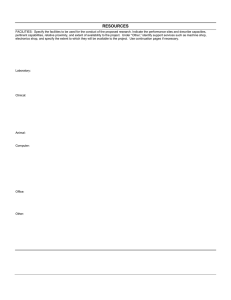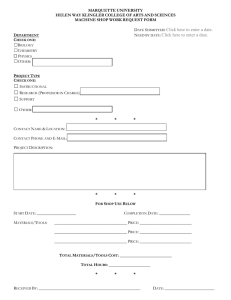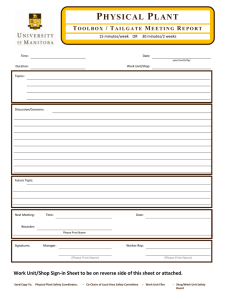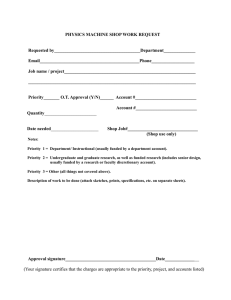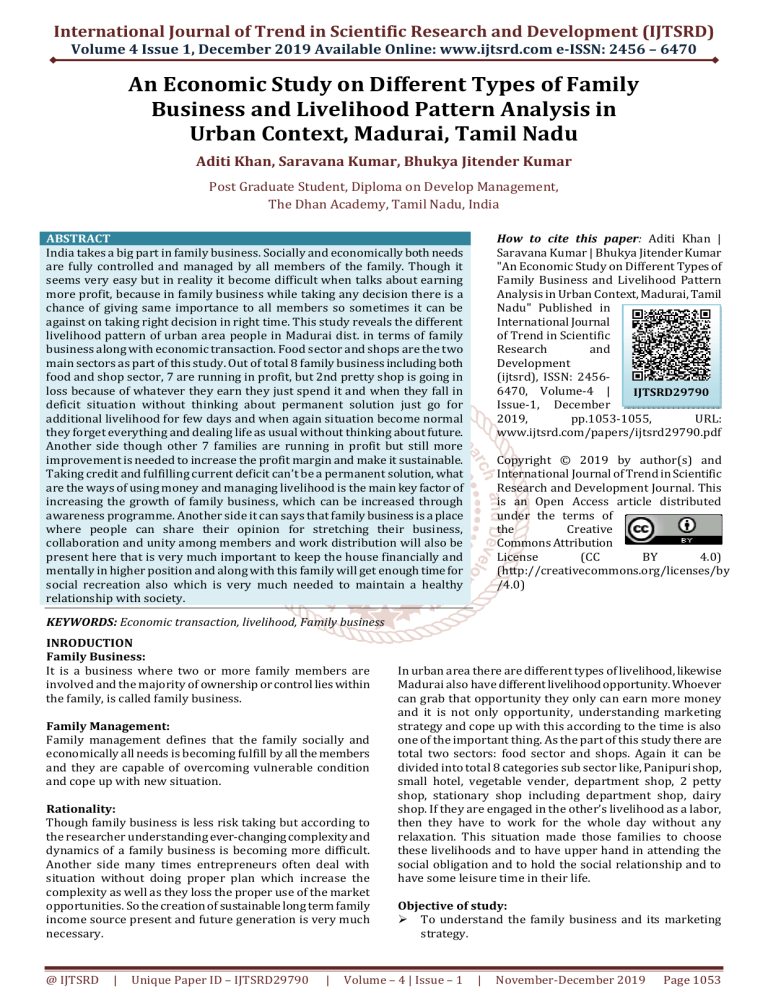
International Journal of Trend in Scientific Research and Development (IJTSRD)
Volume 4 Issue 1, December 2019 Available Online: www.ijtsrd.com e-ISSN: 2456 – 6470
An Economic Study on Different Types of Family
Business and Livelihood Pattern Analysis in
Urban Context, Madurai, Tamil Nadu
Aditi Khan, Saravana Kumar, Bhukya Jitender Kumar
Post Graduate Student, Diploma on Develop Management,
The Dhan Academy, Tamil Nadu, India
ABSTRACT
India takes a big part in family business. Socially and economically both needs
are fully controlled and managed by all members of the family. Though it
seems very easy but in reality it become difficult when talks about earning
more profit, because in family business while taking any decision there is a
chance of giving same importance to all members so sometimes it can be
against on taking right decision in right time. This study reveals the different
livelihood pattern of urban area people in Madurai dist. in terms of family
business along with economic transaction. Food sector and shops are the two
main sectors as part of this study. Out of total 8 family business including both
food and shop sector, 7 are running in profit, but 2nd pretty shop is going in
loss because of whatever they earn they just spend it and when they fall in
deficit situation without thinking about permanent solution just go for
additional livelihood for few days and when again situation become normal
they forget everything and dealing life as usual without thinking about future.
Another side though other 7 families are running in profit but still more
improvement is needed to increase the profit margin and make it sustainable.
Taking credit and fulfilling current deficit can’t be a permanent solution, what
are the ways of using money and managing livelihood is the main key factor of
increasing the growth of family business, which can be increased through
awareness programme. Another side it can says that family business is a place
where people can share their opinion for stretching their business,
collaboration and unity among members and work distribution will also be
present here that is very much important to keep the house financially and
mentally in higher position and along with this family will get enough time for
social recreation also which is very much needed to maintain a healthy
relationship with society.
How to cite this paper: Aditi Khan |
Saravana Kumar | Bhukya Jitender Kumar
"An Economic Study on Different Types of
Family Business and Livelihood Pattern
Analysis in Urban Context, Madurai, Tamil
Nadu" Published in
International Journal
of Trend in Scientific
Research
and
Development
(ijtsrd), ISSN: 24566470, Volume-4 |
IJTSRD29790
Issue-1, December
2019,
pp.1053-1055,
URL:
www.ijtsrd.com/papers/ijtsrd29790.pdf
Copyright © 2019 by author(s) and
International Journal of Trend in Scientific
Research and Development Journal. This
is an Open Access article distributed
under the terms of
the
Creative
Commons Attribution
License
(CC
BY
4.0)
(http://creativecommons.org/licenses/by
/4.0)
KEYWORDS: Economic transaction, livelihood, Family business
INRODUCTION
Family Business:
It is a business where two or more family members are
involved and the majority of ownership or control lies within
the family, is called family business.
Family Management:
Family management defines that the family socially and
economically all needs is becoming fulfill by all the members
and they are capable of overcoming vulnerable condition
and cope up with new situation.
Rationality:
Though family business is less risk taking but according to
the researcher understanding ever-changing complexity and
dynamics of a family business is becoming more difficult.
Another side many times entrepreneurs often deal with
situation without doing proper plan which increase the
complexity as well as they loss the proper use of the market
opportunities. So the creation of sustainable long term family
income source present and future generation is very much
necessary.
@ IJTSRD
|
Unique Paper ID – IJTSRD29790
|
In urban area there are different types of livelihood, likewise
Madurai also have different livelihood opportunity. Whoever
can grab that opportunity they only can earn more money
and it is not only opportunity, understanding marketing
strategy and cope up with this according to the time is also
one of the important thing. As the part of this study there are
total two sectors: food sector and shops. Again it can be
divided into total 8 categories sub sector like, Panipuri shop,
small hotel, vegetable vender, department shop, 2 petty
shop, stationary shop including department shop, dairy
shop. If they are engaged in the other’s livelihood as a labor,
then they have to work for the whole day without any
relaxation. This situation made those families to choose
these livelihoods and to have upper hand in attending the
social obligation and to hold the social relationship and to
have some leisure time in their life.
Objective of study:
To understand the family business and its marketing
strategy.
Volume – 4 | Issue – 1
|
November-December 2019
Page 1053
International Journal of Trend in Scientific Research and Development (IJTSRD) @ www.ijtsrd.com eISSN: 2456-6470
Understanding the potentiality of family business to
scale up the family income in long term basis in urban
context.
What are the gap in family business and find the
appropriate strategy for its sustainability.
Scope of micro finance and institutional development in
family business.
To assess what are the vulnerabilities and how they
cope up with the different situations.
Respondents- Shop owner, Consumer
Individual Orientation
e.g., vision, aspirations, aim, goal.
Inner Human Space
e.g., integrity, identity, selfi shness/
compassion
Emotional Base
e.g., memories, attachments
Family Space
eg: gender, solidarity, relations.
Knowledge and Activity Base
e.g., technology, experience, skills
Figure1 RLS Mandela Livelihood Mode
Mahamayi Chinnachamy has chosen the livelihood Panipuri
on the insisting of her brother’s idea. She started this
livelihood 5 year before and now all the persons in the
family (Herself, Daughter and Son) except her husband are
engaged in this livelihood. She starts her work by afternoon
2pm and then she finishes the post preparation of all the
items by evening 5pm and then their children take all the
materials that was prepared by the mother and then they
will stand the stall by evening 6PM in Theppakulam near
Thaiyagaraja College of Arts. Then in the middle by the time
of 7 to 7.30PM, she will join with them and continue up to 11
pm. This livelihood income is taking care of all the expenses
for their family and as an additional occupation her husband
is working in rice mill whose total income is going to the
savings account. According to her this was one of the best
strategies to have something to manage during the risky
timing. Another side Vairavel family is linking with the dairy
farming where there is a big fluctuation in the income cycle.
Some of the month they go through profit and the remaining
months they had deficit, that compel them to take credit.
This situation came because of the poor management in the
handling of the cow, where she has the three cow that
become pregnant at the same time and middle man also
taking a huge profit margin by receiving the milk at
Rs.27/liter from the families and selling at Rs. 48 to 50/liter
(depending on the market). Immediately there is a need of
changes in managing the cows in the sense rotation of the
lactation period. Instead of selling milk to the middle man,
they can sell the milk to the Kalanjiam members in the
Madurai vattara Kalanjiam either in one or two clusters,
which will give them a high return than giving milk to the
middle man. Before 7 years ago Selvi worked in a hotel with
her cousin brother but because of reducing some work load
|
Methodology:
RLS Mandala will be used as a tool for analysis the particular
family business livelihood of particular family.
1. Personal Interview of a family
2. Focused Group Discussion
Family Orientation
e.g., ancestors, caste, social status, value
Result and Discussion
Food Sector Livelihood: Food sector in the urban livelihood
is making a good amount of gross profit. From this study, it
was found that the magnitude of earning profit (Income:
Expenditure) varies depending on the livelihood that the
families are engaged and the risk that they are taking for
their livelihood. The ratio of income and expenditure of
different livelihoods are Shop: 1.5, Dairy: 2.49 and Hotel: 2.6.
@ IJTSRD
Methodology:
Research Unit:
One single family will be taken, where more than one family
member will link with family business and depth analysis
will be done of that family.
Unique Paper ID – IJTSRD29790
|
Collective Orientation
e.g., religion, tradition, education
Socio-economic Space
e.g., systems of co-operation,
community, organization
Physical Base
e.g., natural resources, assets
and increasing few more income with food security before 3
years ago She opened a new hotel where her family
members also the copartners of this hotel business. This
livelihood gives her better lifestyle where there is some
place of leisure time with flexibility to attend the social
obligation. All the three families are linked with the
Kalanjiam Community Banking Programme, this reflects that
they are linked with saving and credit system but the
condition of the dairy farming family is poor compared to the
other livelihood in this sector because of risk and the poor
management of handling the cows. In a year, this family goes
more time credit, and because of surplus in few months
somehow they manage their condition.
Service Sector livelihood (Shops)
Vegetable Vendor: In this livelihood there all the members
are engaged. Husband used to get the vegetables from the
wholesale in morning and it will be sold to the street
dwellers in the afternoon and in evening. They have their
additional livelihood as milk packet selling, in this the family
can able to sell around 50 Liters and per liter they can get 1
rupee. This family is rearing two goats which were feed by
vegetable wastages that were generated from the vegetable
vendor livelihood. This is one of the excellent measures
which were taken by the family to overcome the risk and at
the same time to use the resource that is available with them.
Husband will collect the vegetables from the wholesale shop
and bring here because the opportunity cost is around
200rs/day, which is not coming into the consideration when
the family is realizing the profit. This family’s next aspiration
is to build a stall, but the entry cost is huge and they are
bounded by the competitors.
Petty shop is a four-year shop which is having an income of
200rs per day. Their working capital will be around 3500 –
4000 worth of goods. She and her son used to maintain this
shop. Her son is also employed in a private company where
his earning is 8000rs/month. This shop has its market with a
confined boundary and they have many competitors after
that boundary. They have the profit margin of 250-300
Rs/day. Now their shop needs a labour to manage because,
Volume – 4 | Issue – 1
|
November-December 2019
Page 1054
International Journal of Trend in Scientific Research and Development (IJTSRD) @ www.ijtsrd.com eISSN: 2456-6470
she (owner) can’t able to manage alone. If a labour is
employed, then the total profit margin which was realized by
the shop will be given to the labour which is not viable. She
has this shop because it is giving a certain income and then
she has her flexibility to attend the social obligation and she
is using this as a tool to hold the customers as a relation for
the betterment of her business. Another petty shop is
running on loss, but the family is not realizing that they are
incurring the loss because of the additional that they are
getting from their son and daughter. All people in this family
are generating income, which is supporting the family to
meet the expenses. Per day 200 worth of goods they will buy
and then they will maintain and sell. This shop is mainly they
have to satisfy the daily expenses, and the other family
member’s income is to be saved. This was their plan. Instead
of that, they are running the business by using the hard
earned money of their children. Even some of the times,
family realizes that there is a deficit in their business, for
that, Husband will do another additional livelihood. He used
to collect the newspaper from different household and then
he used to sale it for the scrap value. Family who are linked
with stationery and Departmental shop the invested the
initial amount of Rs.20000 rupees 15 years before for the
Department shop. For this livelihood, 4 persons in the family
are engaged. The gross income per day for the department
Sector
Food Sector
Shops
Sl. no
1
2
3
4
5
6
7
8
Name of the livelihood
Panipuri
Dairy
Hotel
Vegetable vendor
Petty Shop (1)
Petty Shop (2)
Stationery and departmental
Towel
Conclusion:
Through this survey it is known that except 2nd petty shop all
are in profit, after starting the family business they can
manage their situation because in family business every
member are involved in their work, work load is also
distributed among all, if business is going to be loss all
member of family will together give their effort to revive it. It
is the place where people can share their opinion for
stretching their business, collaboration and unity among
members will also be present there that is very much
important to keep the house financially and mentally in
higher position. But still there is a lot of scope to improve
their business. Each family is losing their opportunity cost to
get the profit margin. Each family is engaged in this kind of
@ IJTSRD
|
Unique Paper ID – IJTSRD29790
|
store is Rs.4000-5000 and for the stationery shop it is 1000
Rs/day. Stationery shop was 4 years old. Before there was a
stationery shop which was maintained by someone, while
they left that place she grabbed the opportunity and opened
the same kind of shop. She felt that, there is a demand for
stationery shop which can be used for their business. She
was doing the additional livelihood like weaving, but later
onwards she left that. The family’s next aspiration is to scale
up the business like whole sale instead of selling directly to
the customers. Another side towel manufacturing business
holding family started their business then the women of the
family took up the lead for running and maintaining this
business. Her husband’s primary occupation is driving. This
shop is a manufacturing unit where they will get orders for
the towel from different companies. All the raw materials
will be given by the companies those who are giving orders.
Value addition will be taken care by herself and her
employees. In their manufacturing unit they have 8 power
machines and the initial cost is Rs. 100000. 7 members are
employed. The bonding between herself and her employee
was quite good. Three days once, this production unit can do
600 dozen. Now they are planning to diversify the products
like night dress for women and others. This business is
earning a profit of 15000 Rs/Month.
Annual Income
450000
182250
600000
286000
182000
120000
700000
420000
Annual Expenditure
300000
73000
225000
234000
156000
150000
312000
240000
Profit / (Loss)
150000
109250
375000
52000
26000
-30000
388000
180000
livelihood majorly to have flexibility in their timing of doing
the livelihood and also to attend the social obligation to
withhold the relationship with the neighbors and the other
relatives. In Dairy farming it may be looking like they are
realizing profit but the poor practices of dairy farming can be
seen in that family, where at a time three cows are pregnant.
This implies that the three cows will reach the dry period at
the same time. During that time, the family has a huge
demand for the money or credit to meet their daily expenses
of the family. Still they are not realizing that, how they are
managing the family during this draught period. Likewise,
there are some unawareness needs to lure out, then only this
kind of family urban livelihood can give a meaningful income
to the whole family.
Volume – 4 | Issue – 1
|
November-December 2019
Page 1055

